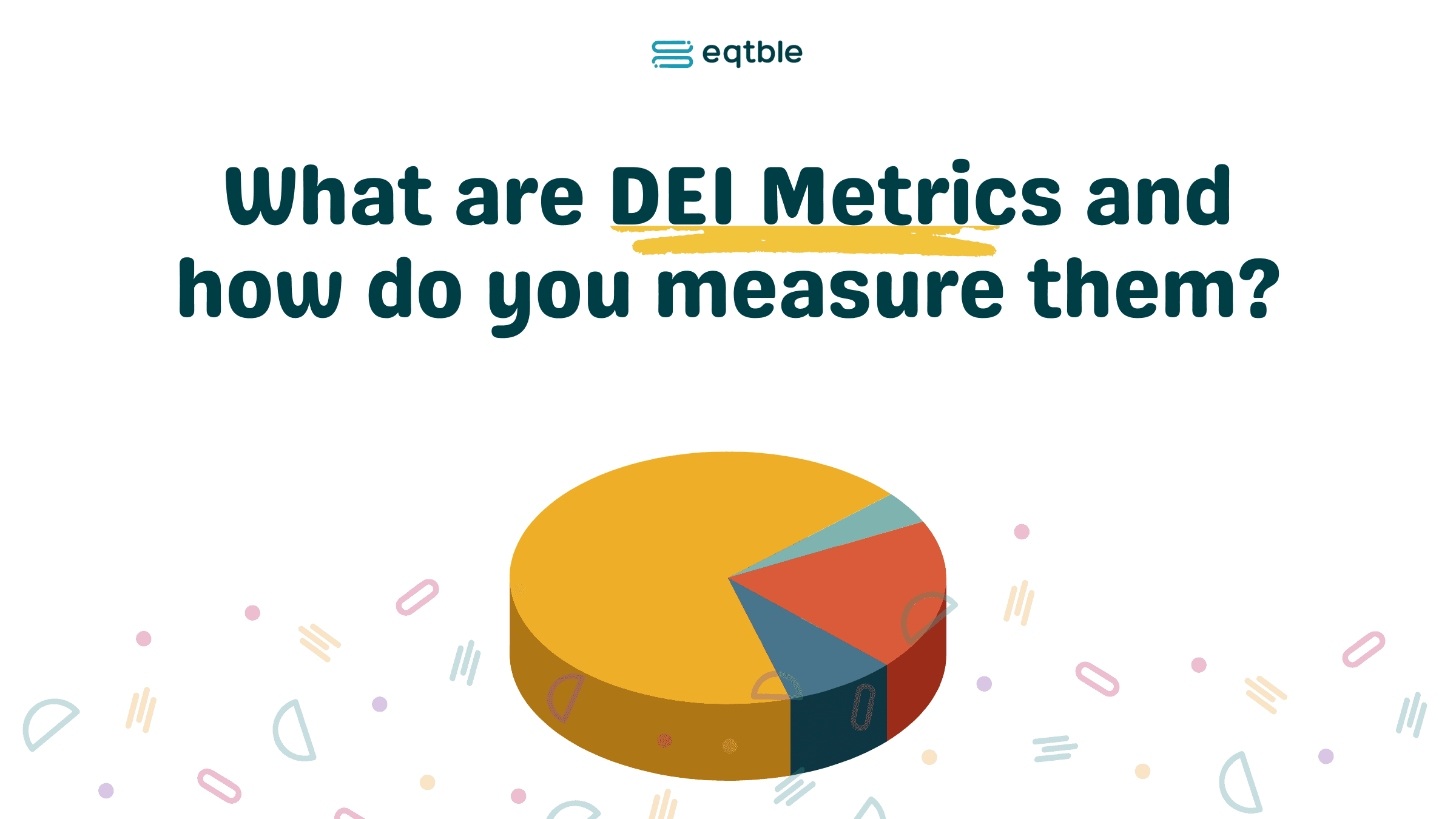Diversity & Inclusion
July 18, 2022
What are DEI Metrics and how do you measure them?
Business and society are profoundly linked. That’s never been more evident. But why?
In recent history, the social fabric has been routinely torn at the seams. And, while America’s political and social landscape has always been fraught, it’s never been quite this divisive.
Social media, disinformation, the rise of populism, the granular segmentation of groups and ideologies – there’s been a lot to unpack in the last 5 years alone.
And then, Covid happened.
Existing divides grew wider. Spotlights were shone brightly on inequality. Work, life – everything changed. Lives were altered, or tragically cut short.
Not just by the virus.
The world watched as inequality and racism bore their teeth. And the business world responded; mostly with token gestures.
But some companies – the global leaders, the elite-level performers – they know that real change and progress don’t come from performative social media posts.
Inequality, society, and business are all linked, and digging to the root of a problem is the only way to solve it.
They know that Diversity, Equity and Inclusivity (DEI) measures are the key to change. And that walking that path isn’t just good for society; it’s good for business.
Life may never be the same again. But in some ways, the change is overwhelmingly positive.
It feels as if the value of life is now at an all-time high, as we share an emerging and constantly evolving threat. As a side effect, we’ve got phenomena like the Great Resignation – and a perceived shrinking of the labor market.
What if we told you that, instead of being smaller, the talent pool could become exponentially bigger with DEI initiatives?
It’s what a lot of companies are coming to realise. The turmoil and challenges of recent memory have culminated in the acceleration of DEI, with more companies than ever seeking the path towards more diverse and inclusive workplaces.
But this acceleration has raised more questions than answers:
How do you “do” DEI?
What are DEI metrics?
Which DEI metrics should you measure, and how?
Let’s break it down to the basics before looking at useful, meaningful ways to implement and track DEI metrics.
What are DEI metrics?
DEI metrics are used to quantify the diversity, equity and inclusivity among employees at all levels in an organization.
They are how diversity and inclusivity are measured.
Some DEI metrics show the financial return that diversity and inclusion programs bring in. These are useful for stakeholders, and can strengthen leadership commitment and internal advocacy.
Some DEI metrics can be used to build employee trust, satisfaction, and engagement. They can also boost the organization’s brand and reputation.
DEI metrics are objective; this can make the emotional weight of the subject matter far lighter, by giving empirical evidence to base decisions on.
As a result, decision-making can become faster, with a truer sense of reality and better outcomes.
What do diversity metrics measure?
DEI metrics can be used to measure any demographic attribute, company initiative, or employee feedback that falls within the scope of DEI.
Demographic metrics
Demographics can include (but isn’t limited to) the following employee data:
LGBTQ+ identity
Disability and accessibility
Racial and ethnic identity
Religion
Gender identity
Age
Nationality
Education
While this might seem the most important and progressive avenue to pursue – it’s really sensitive.
Capturing this data in the first place will be difficult if employees or candidates do not trust the organization.
People need to feel safe enough to divulge certain things about themselves, especially if they’ve been persecuted, bullied, or diminished in the past because of what or who they are.
Some of this information may have never been divulged to anyone before.
Focusing too heavily on demographic metrics can be alienating to your people or to candidates, leading to false information and skewed data.
This can lead to faulty decision-making. At worst, a heavy-handed push for this data can lead to resentment.
On the flipside, ignoring demographics entirely gives you no way of setting or tracking targets, and no way to implement change.
Educating and fostering trust within your teams and among candidates is the essential first phase of any DEI initiative.
You can’t accurately measure anything if the data you get is flawed – and transparent communication can facilitate it all.
One way of getting closer to that ideal is with employee surveys.
Survey and feedback metrics
By tying together known demographics data and survey feedback, a more accurate picture of your organization’s DEI landscape can be built.
Getting ranked from 1 to 5 on statements like “I belong here”, “I can express my opinion without repercussion”, “I believe leadership respects everyone equally”, “I have opportunities to learn and grow” – these can give valuable insight into how employees feel about their place in the organization.
Related: Employee engagement surveys
When demographics data is factored in, do certain groups respond in similar ways? Do some people feel left out of opportunities, or that leadership doesn't treat them with the same level of respect as their counterparts?
Initiatives
Initiatives are easier to track and measure, and include things like the number of accessible entries and exits in company buildings, or how many gender neutral bathrooms are in operation.
Further initiatives can be set – like encouraging more staff to attend DEI events, hosting, or sponsoring DEI events.
Company overview
Understanding how improved diversity affects the bottom-line is a key metric. Stakeholders and leadership will be interested to see:
Revenue correlated to increases in diversity
Sales
Revenue per employee, segmented by other key DEI metrics
Brand sentiment
Remember that DEI seeks to enable everyone; not just your diverse employees. It will certainly improve a company, but it won’t be the sole reason for financial success.
HR metrics
Correlation between promotions, pay, turnover and demographics can be a significant indicator of how your organization interacts with certain groups of employees.
Look for patterns in turnover rates and promotions against demographics and survey responses. Look for shortfalls in DEI initiatives which may have prompted exits.
Read more: Attrition vs turnover
These are the pivotal points in the data that build the story – and let you flip the script.
Benchmarking and external factors
Last – but by no means least – is benchmarking and outside-of-company factors that can affect DEI. Benchmarking includes comparing your company to direct competitors, but also to the overall labor market, industry verticals, and to the companies you aspire to be like.
And while you’re looking outside of your organisation, pay attention to your suppliers and contractors. Carry out due diligence checks: do all of your suppliers align with your guiding principles on DEI?
How do you measure DEI?
To measure DEI, you need to know two things; where your company stands right now on DEI, and a goal that you want to achieve. Without one or the other, an organization can’t advance.
Knowing the current state of play is a vital risk-assessment. It will help prioritize the most urgent requirements, and help you understand the root causes of problems. It will also help you understand which data are useful or the gaps in your data capture process.
Goals give you something to aim for – but they must be Specific, Measurable, Achievable, Relevant, and Time-bound (SMART). Goals make us accountable and give us a timeline to success – but without knowing where we start, we’ll have no yardstick, no benchmark.
The steps to measure DEI at your company might look like this:
Collect all available HR analytics data
Perform a data audit
Analyze the data and spot issues or opportunities
Create goals that address those issues and opportunities
Plan a path to achieve those goals
Monitor, track, and change course as necessary
Start over again
How to use data to meet your DEI goals
How would your company use data to meet sales goals? Or to reduce overheads?
The same data-driven principles need to be applied to your DEI objectives. Use the same planning, feedback, and accountability processes used in sales and budgeting – only instead of financial capital, think in terms of human capital.
Capture the data at the recruitment, onboarding, one to one and career progression phases. Take on feedback, study turnover and attrition, exit interview data – record every stage in the employee lifecycle, and combine it with DEI metrics.
What’s the story the data is telling you? That’s where you’ll find the answers.
7 meaningful DEI metrics to help you launch your DEI program
Every organization is different. But here are some ideas that can help you get into the right mindset with DEI – and help you prioritize your strategies.
Hiring: employee diversity vs. applicant diversity
If your applicants are diverse but your team is not, your organization may be struggling with hiring bias.
Leadership diversity
Representation matters. If junior and entry level employees are extremely diverse, but leadership is not – bias may be at play in career progression and hiring phases.
Job satisfaction among demographics
If your people feel happy at work, they’re likely to feel included, too. But for deeper insight, make sure you segment your surveys into job satisfaction and how welcome a person feels – because these don’t necessarily align. Overall happiness at work doesn’t give the full picture.
Pay and equity
Compare pay and company equity among your monitored groups; for example, do men earn more, on average, than women? Does this occur in other monitored groups?
Turnover
If your monitored groups are leaving at a higher rate, you could have issues with inclusivity, company culture, and progression among your diverse employees. Look at retention through the lens of job satisfaction; what were the triggers for exit? What can you glean from your exit interview process?
Progression
Are employees of all groups and backgrounds given the same development opportunities – or do promotions all have similar demographics? Consider this carefully. Are you committed only to hiring more diverse talent, or to a thriving, diverse, inclusive organization?
Accessibility
Is your organization inclusive of disabled people? Are there physical amenities or opportunities to work from home? Are disabled people represented across the company, from leadership down?
How do you measure diversity and inclusion success?
Success is whatever you define it to be.
Just like there’s no universal set of metrics to measure diversity and inclusion, there are no universal goals to achieve. Goals should be individually tailored to every organization.
Maybe you want to improve leadership diversity, or achieve equal pay.
Whatever you choose as a goal, keep it simple; focus on priorities first and don’t seek to solve all your problems at once.
Success takes diligence and commitment. And with DEI, it takes tools, too.
Track the DEI metrics that matter
eqtble lets you actively track DEI metrics at your organization – and gives you actionable insights on how to achieve your goals.
We help companies understand their DEI metrics and achieve success with our groundbreaking, data-driven platform; and the world’s most advanced DEI metrics dashboard.
eqtble works with major HCM and HR tools, with seamless integration. Plug in your data, and eqtble does the rest. Sign up for early access. It’s free!







